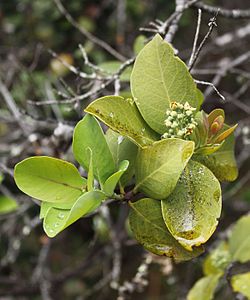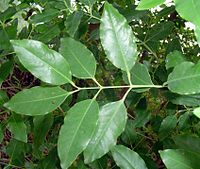- Sandalwood
-
For other uses, see Sandalwood (disambiguation).
Sandalwood is the name of a class of fragrant woods from trees in the genus Santalum. The woods are heavy, yellow, and fine-grained, and unlike many other aromatic woods they retain their fragrance for decades. As well as using the harvested and cut wood in-situ, essential oils are also extracted from the woods for use. Both the wood and the oil produce a distinctive fragrance that has been highly valued for centuries. Consequently, the slow-growing trees have been overharvested in many areas.
Contents
True sandalwoods
Sandalwoods are medium-sized hemiparasitic trees. Notable members of this group are Indian sandalwood (Santalum album) and Australian sandalwood (Santalum spicatum). Others in the genus species have fragrant wood. These are found in India, Bangladesh, Sri Lanka, Australia, Indonesia, and the Pacific Islands. In India, Bangladesh and Sri Lanka it is called Chandan.
- Santalum album, or Indian sandalwood, is a threatened species. It is indigenous to South India, and grows in the Western Ghats and a few other mountain ranges like the Kalrayan and Shevaroy Hills. Although sandalwood trees in India and Nepal are government-owned and their harvest is controlled, many trees are illegally cut down. Sandalwood oil prices have risen to $1,000–1,500 per kg recently. Some countries regard the sandal oil trade as ecologically harmful as it encourages overharvesting sandalwood trees. Sandalwood from the Mysore region of Karnataka (formerly Carnatic), Southern India is high quality. New plantations were created with international aid in Tamilnadu for economic exploitation. In Kununurra in Western Australia, Indian sandalwood (Santalum album) is grown on a large scale.
- Santalum ellipticum, S. freycinetianum, and S. paniculatum, the Hawaiian sandalwood (ʻiliahi), were also used and considered high quality. These three species were exploited between 1790 and 1825 before the supply of trees ran out (a fourth species, S. haleakalae, occurs only in subalpine areas and was never exported). Although S. freycinetianum and S. paniculatum are relatively common today, they have not regained their former abundance or size, and S. ellipticum remains rare.[1][2]
- Santalum spicatum (Australian sandalwood) is used by aromatherapists and perfumers. The concentration differs considerably from other Santalum species. In the 1840s, sandalwood was Western Australia’s biggest export earner. Oil was distilled for the first time in 1875, and by the turn of the century there was intermittent production of Australian sandalwood oil.
Production
Producing commercially valuable sandalwood with high levels of fragrance oils, requires Santalum trees to be a minimum of eight years old, but at least fourteen years is preferred. Australia is the largest producer of Santalum album, the majority grown around Kununurra, Western Australia.
Unlike most trees, sandalwood is harvested by toppling the entire tree instead of sawing them down at the trunk close to ground level. This way, wood from the stump and root can also be used.
Usage
Fragrance
Sandalwood essential oil provides perfumes with a striking wood base note. Sandalwood smells somewhat like other wood scents, except it has a bright and fresh edge with few natural analogues. When used in smaller proportions in a perfume, it is an excellent fixative to enhance the head space[clarification needed] of other fragrances.
Sandalwood oil is widely used in the cosmetic industry. The main source of true sandalwood, S. album, is a protected species, and demand for it cannot be met. Many species of plants are traded as "sandalwood". Within the genus Santalum alone, there are more than nineteen species. Traders will often accept oil from closely related species, such as various species in the genus Santalum, as well as from unrelated plants such as West Indian Sandalwood (Amyris balsamifera) in the family Rutaceae or bastard sandalwood (Myoporum sandwicense, Myoporaceae). However, most woods from these alternative sources will lose their aroma within a few months or years.
Isobornyl cyclohexanol is a synthetic fragrance chemical produced as an alternative to the natural product.
Hinduism
Sandalwood paste is integral to rituals and ceremonies, to mark religious utensils and to decorate the icons of the deities. It is also distributed to devotees, who apply it to the forehead or the neck and chest. Preparation of the paste is a duty fit only for the pure, and is therefore entrusted in temples and during ceremonies only to priests.
The paste is prepared by grinding wood by hand upon granite slabs shaped for the purpose. With slow addition of water a thick paste results, which is mixed with saffron or other such pigments to make Chandana.
Sandalwood is considered in alternative medicine to bring one closer to the divine. It gives a cool soothing effect to the body thus reducing the body heat. In Thirupathi after religious tonsure, Sandal paste is applied to protect the skin. Sandalwood essential oil is used for Ayurvedic purposes and treating anxiety.
Buddhism
Sandalwood is considered to be of the padma (lotus) group and attributed to Amitabha Buddha. Sandalwood scent is believed to transform one's desires and maintain a person's alertness while in meditation. Sandalwood is also one of the more popular scents used for incense used when offering incense to the Buddha.
Chinese and Japanese Religions
Sandalwood, along with agarwood, is the most commonly used incense material by the Chinese and Japanese in worship and various ceremonies. It is used in Indian incense, religiously or otherwise.
Zoroastrianism
Zoroastrians offer sandalwood twigs to the firekeeping priests who offer the sandalwood to the fire which keep the fire burning. Sandalwood is offered to all of the three grades of fire in the Fire temple, including the Atash Dadgahs. Sandalwood is not offered to the divo, a homemade lamp. Often, money is offered to the mobad along with the sandalwood. Sandalwood is called sukhar in the Zoroastrian community. The sandalwood in the fire temple is often more expensive to buy than at a Zoroastrian store. It is often a source of income for the fire temple.
Medicine
Sandalwood essential oil was popular in medicine up to 1920-1930, mostly as an urogenital (internal) and skin (external) antiseptic. Its main component beta-santalol (~90%) has antimicrobial properties. It is used in aromatherapy and to prepare soaps. Due to this antimicrobial activity, it can be used to clear skin from blackheads and spots, but it must always be properly diluted with a carrier oil. Because of its strength, sandalwood oil should never be applied to the skin without being diluted in a carrier oil.
Technology
Due to its low fluorescence and optimal refractive index, sandalwood oil is often employed as an immersion oil within ultraviolet and fluorescence microscopy.
Distillation
Sandalwood is distilled in a four-step process, incorporating boiling, steaming, condensation and separation.
Food
Australian Aboriginals eat the seed kernels, nuts, and fruit of local sandalwoods, such as quandong (Santalum acuminatum).[citation needed]
See also
References
- ^ Wagner, W. L., D. R. Herbst, and S. H. Sohmer (1990). Manual of the Flowering Plants of Hawaii. Honolulu: University of Hawaii Press.
- ^ Rock, J. F. (1913). The Indigenous Trees of the Hawaiian Islands. Honolulu.
- Mandy Aftel, Essence and Alchemy: A Natxbigjbijbjoural History of Perfume, Gibbs Smith, 2001, ISBN 1-58685-702-9
External links
Wikimedia Foundation. 2010.




